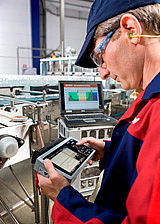|
|
An ECO Audit™ has two main steps. The first involves two Sidel engineers who collect data on site for one week using innovative measurement equipment. For example, the amperage measurement apparatus installed on a complete line can be used to analyze up to 15 machines at once. These tools can also be used to make continuous recordings of the line’s various consumption levels without intrusion, i.e. without any mechanical intervention required on the line itself.
The second step is data analysis and reporting. This report is sent to the customer less than three weeks after the audit. The report’s recommendations for improving line efficiency and reducing energy consumption are adapted to the customer’s needs and schedule. There are three focus areas: excessive consumption by the machines, related to tuning or ageing issues; consumption levels that vary with line productivity (the better we produce, the less we consume); and finally, nonproductive consumption, i.e. all water and energy consumption recorded during the draining, format changeover and cleaning phases and during breaks and shutdowns, all of which can be optimized.
For the past two years, Sidel has been working on new sustainability solutions for complete lines. This work has led to the creation of the ECO Audit™, the newest member of the Sidel ECO Services family, joining ECO Booster™ and ECO EIT™.
ECO Audit: A snapshot of the line
An ECO Audit™ is a snapshot of a complete line’s situation in full production. There are two majorobjectives: first, to evaluate any gaps in production performance and energy consumption between thereal operation of the line and its original specifications, and second, to establish a reference point andidentify levers for an improvement plan aimed at generating energy savings or improving performancequickly based on concrete recommendations. The ECO Audit™ is also used to quantify subjective dataconcerning the line’s performance so that actions can be planned and implemented in order to meet theagreed targets in the allotted time. The ECO Audit™ also summarizes the line’s potential to reach a“World-Class” production level in the medium or long term.
Correlation between performance measurements and consumption
In addition, to reduce water and power consumption and to cut production costs, it is necessary to have aprecise analysis of all line consumptions (power, air, steam, water, CO2, etc.) at the same time asequipment performance is determined (line efficiency, machine reliability, changeovers, cleaningoperations, shutdowns).






